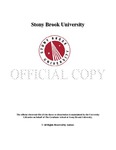| dc.identifier.uri | http://hdl.handle.net/1951/55514 | |
| dc.identifier.uri | http://hdl.handle.net/11401/70889 | |
| dc.description.sponsorship | This work is sponsored by the Stony Brook University Graduate School in compliance with the requirements for completion of degree. | en_US |
| dc.format | Monograph | |
| dc.format.medium | Electronic Resource | en_US |
| dc.language.iso | en_US | |
| dc.publisher | The Graduate School, Stony Brook University: Stony Brook, NY. | |
| dc.type | Dissertation | |
| dcterms.abstract | Population genetics reduces the description of a population to a set of genotype frequencies. Because of this, it has been called"beanbag genetics.". However, greater complexity and biological realism can be incorporated into this framework. Two examples of this include interactions between different genes (epistasis) and individuals with the same genotype that have different phenotypes (incomplete penetrance). During the course of my Ph.D. work, both of these topics were investigated using theoretical population genetics and Drosophila genetics. One unifying theme was that genes do not exist in isolation: they occur within genetic and environmental contexts. In turn, these contexts were found to affect the evolution of populations.The above considerations were addressed via four interlocking studies. First, we studied epistatic interactions between naturally segregating chromosomes in D. melanogaster. We placed a number of X chromosomes into multiple genetic backgrounds, finding that many X-autosome combinations were lethal or sterile. X-autosome incompatibilities also exhibited sex-specific and geographic patterns. Second, population genetics theory was extended to encompass X-autosome interactions. Allele frequency trajectories were calculated and found to be consistent with relatively high levels of segregating variation. This also led to testable predictions about the early stages of Haldane's rule. Third, we studied the incomplete penetrance of a naturally occurring mutation affecting wing development in D. melanogaster. This mutation was found to be allelic with the vesiculated gene. Subsequent tests examined how genetic background, temperature, sex, and maternal effects affected the presence and severity of wing vesiculation. Fourth, the theoretical population genetics of incomplete penetrance was developed. Mean fitness accurately predicted the evolutionary trajectories of beneficial alleles. However, fitness variance and maternal effects greatly affected the evolution of incompletely penetrant alleles that were neutral on average. Together, these four studies illustrate the complexity of natural genetic variation and suggest how it might have evolved. | |
| dcterms.available | 2012-05-15T18:04:45Z | |
| dcterms.available | 2015-04-24T14:45:00Z | |
| dcterms.contributor | True, John R. | en_US |
| dcterms.contributor | Walter F. Eanes | en_US |
| dcterms.contributor | Daniel E. Dykhuizen | en_US |
| dcterms.contributor | Joshua Rest | en_US |
| dcterms.contributor | Stephen B. Munch. | en_US |
| dcterms.creator | Lachance, Joseph | |
| dcterms.dateAccepted | 2012-05-15T18:04:45Z | |
| dcterms.dateAccepted | 2015-04-24T14:45:00Z | |
| dcterms.dateSubmitted | 2012-05-15T18:04:45Z | |
| dcterms.dateSubmitted | 2015-04-24T14:45:00Z | |
| dcterms.description | Department of Genetics | en_US |
| dcterms.format | Application/PDF | en_US |
| dcterms.format | Monograph | |
| dcterms.identifier | Lachance_grad.sunysb_0771E_10319.pdf | en_US |
| dcterms.identifier | http://hdl.handle.net/1951/55514 | |
| dcterms.identifier | http://hdl.handle.net/11401/70889 | |
| dcterms.issued | 2010-12-01 | |
| dcterms.language | en_US | |
| dcterms.provenance | Made available in DSpace on 2012-05-15T18:04:45Z (GMT). No. of bitstreams: 1
Lachance_grad.sunysb_0771E_10319.pdf: 16066000 bytes, checksum: 3aa56639671f32ddd06f6fa2a936f430 (MD5)
Previous issue date: 1 | en |
| dcterms.provenance | Made available in DSpace on 2015-04-24T14:45:00Z (GMT). No. of bitstreams: 3
Lachance_grad.sunysb_0771E_10319.pdf.jpg: 3187 bytes, checksum: 17066d4449db985bb006951a280eccb1 (MD5)
Lachance_grad.sunysb_0771E_10319.pdf.txt: 325274 bytes, checksum: 08561139ecb92e740c242bf174fe79e3 (MD5)
Lachance_grad.sunysb_0771E_10319.pdf: 16066020 bytes, checksum: c95aedc4d73544e7f2e74c77fbb0046c (MD5)
Previous issue date: 1 | en |
| dcterms.publisher | The Graduate School, Stony Brook University: Stony Brook, NY. | |
| dcterms.subject | Genetics -- Mathematics | |
| dcterms.subject | Drosophila, epistasis, penetrance, theoretical population genetics | |
| dcterms.title | Life after beanbag genetics: theoretical and empirical studies on epistasis and penetrance | |
| dcterms.type | Dissertation | |

